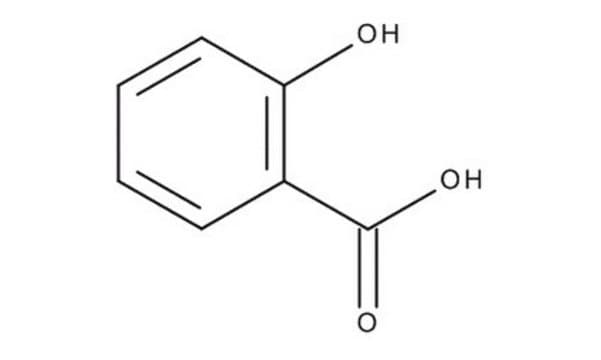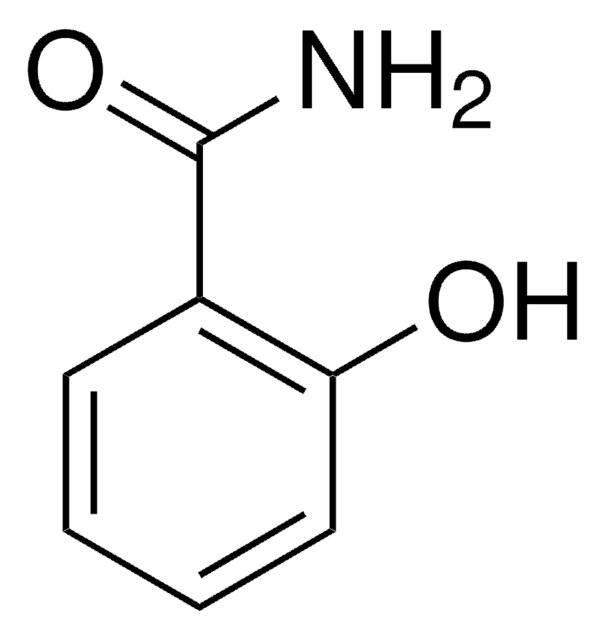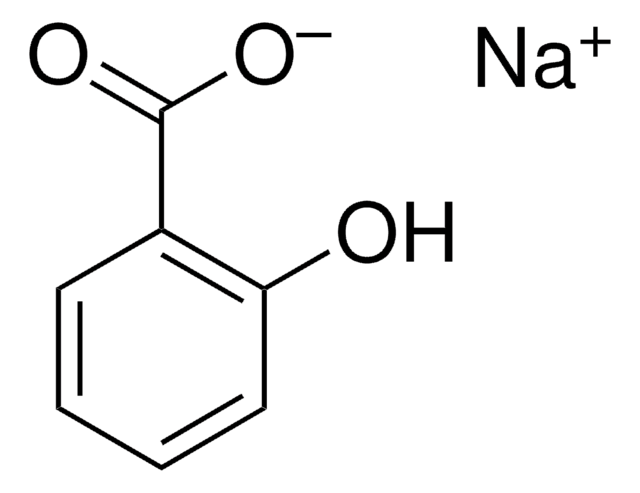1609002
USP
Salicylic acid
United States Pharmacopeia (USP) Reference Standard
Synonym(s):
2-Hydroxybenzoic acid
About This Item
Recommended Products
grade
pharmaceutical primary standard
vapor density
4.8 (vs air)
vapor pressure
1 mmHg ( 114 °C)
API family
salicylic acid
manufacturer/tradename
USP
bp
211 °C (lit.)
mp
158-161 °C (lit.)
solubility
alcohol: freely soluble
benzene: slightly soluble
boiling water: soluble
chloroform: sparingly soluble
ether: freely soluble
toluene: slightly soluble
water: slightly soluble
density
1.44 g/cm3 at 20 °C
application(s)
pharmaceutical (small molecule)
format
neat
SMILES string
OC(=O)c1ccccc1O
InChI
1S/C7H6O3/c8-6-4-2-1-3-5(6)7(9)10/h1-4,8H,(H,9,10)
InChI key
YGSDEFSMJLZEOE-UHFFFAOYSA-N
Looking for similar products? Visit Product Comparison Guide
General description
Application
Also used to prepare standard solutions for the assay, impurity analysis, and performance test by using liquid chromatography in conjunction with a UV detector according to the given below monographs of United States Pharmacopeia (USP) :
- Salicylic Acid
- Methyl Salicylate
- Magnesium Salicylate Tablets
- Aspirin Boluses
Analysis Note
Other Notes
related product
Signal Word
Danger
Hazard Statements
Precautionary Statements
Hazard Classifications
Acute Tox. 4 Oral - Eye Dam. 1 - Repr. 2
Storage Class Code
13 - Non Combustible Solids
WGK
WGK 1
Flash Point(F)
314.6 °F - closed cup
Flash Point(C)
157 °C - closed cup
Choose from one of the most recent versions:
Certificates of Analysis (COA)
Sorry, we don't have COAs for this product available online at this time.
If you need assistance, please contact Customer Support.
Already Own This Product?
Find documentation for the products that you have recently purchased in the Document Library.
Customers Also Viewed
Protocols
Separation of Acetylsalicylic acid, analytical standard; Salicylic acid, BioXtra, ≥99.0%
Separation of Salicylic acid, meets analytical specification of Ph. Eur., BP, USP, 99.5-100.5% (calc. to the dried substance); Acetylsalicylic acid, purum, ≥99.0% (HPLC)
Separation of 4-Hydroxybenzoic acid; Acetylsalicylic acid; Benzoic acid; Salicylic acid; Ethyl 4-hydroxybenzoate
HPLC Analysis of Benzoic Acid Derivatives on Ascentis® C18
Our team of scientists has experience in all areas of research including Life Science, Material Science, Chemical Synthesis, Chromatography, Analytical and many others.
Contact Technical Service










